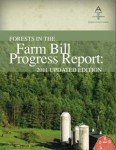22 Jun On the ground success: Farm Bill programs working in Minnesota
Nancy Livingston, a Wisconsin Tree Farmer, had settled into her hard-earned retirement when a wildfire tore through her forest. Leaving the land barren, the fire destroyed years of work. To restore her forest, she came out of retirement, but even then, Nancy didn’t have the resources she needed. So she turned to the Wisconsin Department of Natural Resources and the U.S. Department of Agriculture (USDA), where she found the helping hand she needed to restore her woodlands.
 In 2008, Congress made important changes to USDA conservation programs—opening them up to family forest owners and improving the health of America’s woodlands. Tree Farmers like Nancy now have the tools needed to do right by the land—whether it’s managing for wildlife, improving stream crossings, or protecting against fire and invasive insects.
In 2008, Congress made important changes to USDA conservation programs—opening them up to family forest owners and improving the health of America’s woodlands. Tree Farmers like Nancy now have the tools needed to do right by the land—whether it’s managing for wildlife, improving stream crossings, or protecting against fire and invasive insects.
Congress just started rewriting the Farm Bill, which could change how the programs work and affect forest owners. We need your help to share the successes of Farm Bill conservation programs for family forests! Learn how Farm Bill programs are working for families across the country in a new AFF report that was released today: Forests in the Farm Bill Progress Report: 2011 Updated Edition. Please send the report to your member of Congress and share with them how important farm bill conservation programs are for the health of woodlands in Minnesota. Also share the report with your local forestry department staff and NRCS offices, your state forestry association and anyone else you think would be interested.
Nearly 40,000 families with woodlands participated in Farm Bill programs last year, including the Pionkes who used the Conservation Stewardship Program to restore and diversity their Pennsylvania Tree Farm after a devastating gypsy moth infestation. Read their story and others in the report.
Despite the success of the programs, some members of Congress have proposed deep cuts to the programs, which would make it difficult for USDA to provide technical assistance and management tools to family forest owners for years to come. While we understand that cuts must be made, and conservation programs must be a part of any debt solution, the budget cannot and should not be balanced on the back of conservation.
Congress just started rewriting the Farm Bill, which could change how the programs work and affect forest owners. We need your help to share the successes of Farm Bill conservation programs for family forests! Please send the report to your member of Congress and share with them how important farm bill conservation programs are for the health of woodlands in Minnesota. Also share the report with your local forestry department staff and NRCS offices, your state forestry association and anyone else you think would be interested.
“A lot of people think forest management is a one-man show. It’s not. I definitely put my own sweat, labor and money, but I’ve gotten a lot of help, too. I couldn’t have done it without some financial help and all of the technical advice…” said John Traylor, Georgia Tree Farmer. Read John’s story and more in AFF’s report.
If you have any questions about the Progress Report or Farm Bill programs, don’t hesitate to contact us at AFF.
Thank you for your support,
Dan Conant
Public Affairs Manager
American Forest Foundation
phone: (202)463-2431
email: [email protected]

